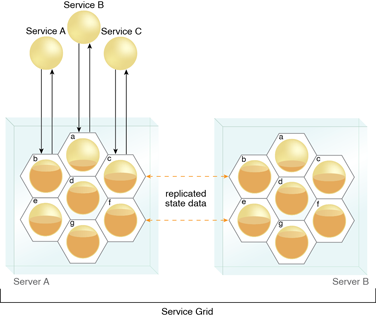SOA Patterns > Inventory Implementation Patterns > Service Grid
Service Grid (Chappell)
How can deferred service state data be scaled and kept fault-tolerant?

Problem
State data deferred via State Repository or Stateful Services can be subject to performance bottlenecks and failure, especially when exposed to high-usage volumes.
Solution
State data is deferred to a collection of stateful system services that form a grid that provides high scalability and fault tolerance through memory replication and redundancy and supporting infrastructure.
Application
Grid technology is introduced into the enterprise or inventory architecture.
Impacts
This pattern can require a significant infrastructure upgrade and can correspondingly increase governance burden.
Principles
Architecture
Enterprise, Inventory, Service

A service grid establishes replicated instances of stateful grid services across different server machines, resulting in increased scalability and reliability of state data. (A grid service is represented by the standard service symbol enclosed in a honeycomb cell.)
Related Patterns in This Catalog
Canonical Resources, Cross-Domain Utility Layer, Messaging Metadata, Partial State Deferral, State Repository, Stateful Services
Related Service-Oriented Computing Goals
Increased Organizational Agility, Increased ROI, Increased Vendor Diversification Options, Reduced IT Burden
This page contains excerpts from:
SOA Design Patterns by Thomas Erl
(ISBN: 0136135161, Hardcover, Full-Color, 400+ Illustrations, 865 pages)
For more information about this book, visit www.arcitura.com/books.
